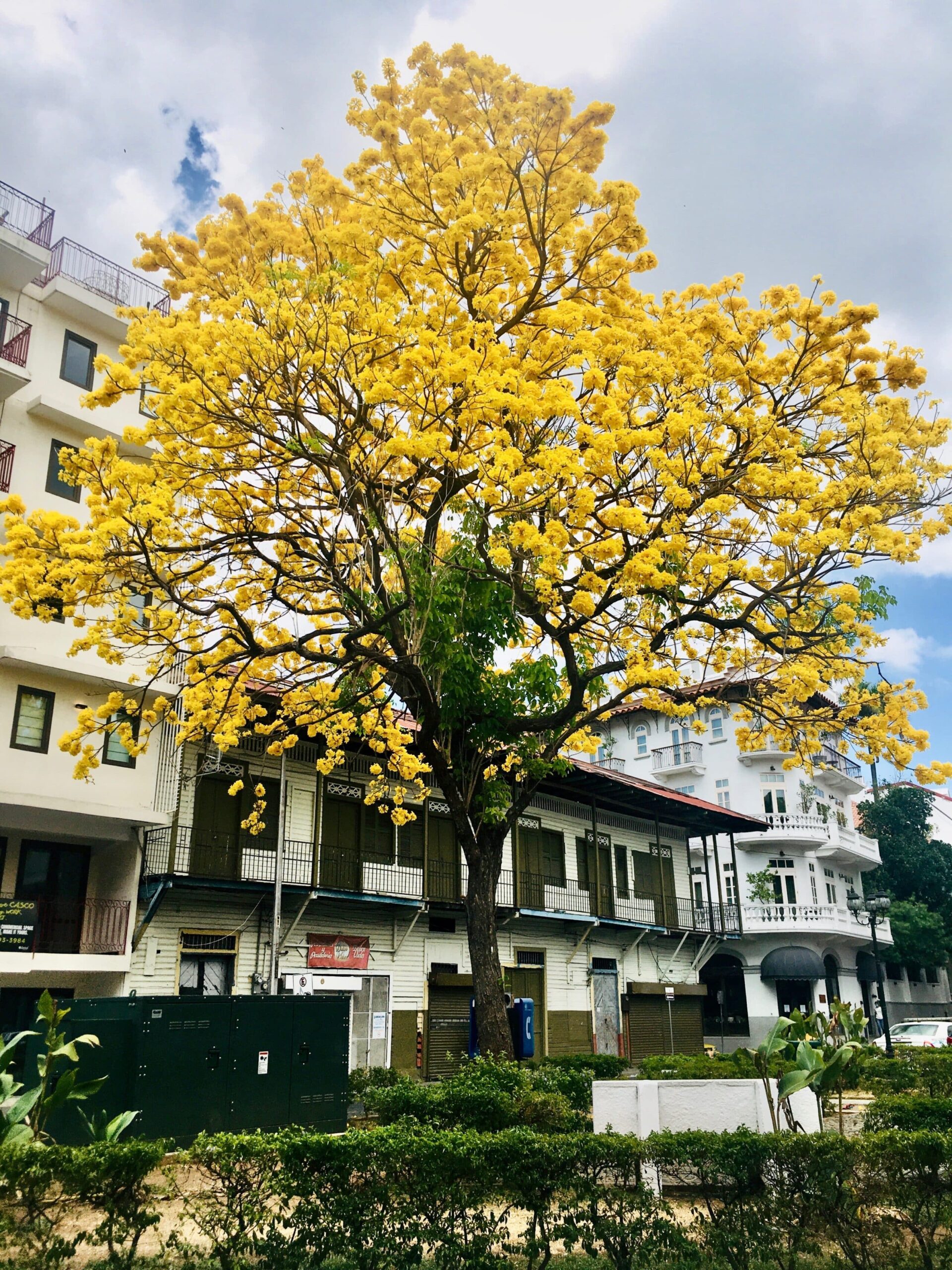If you are Panamanian, one of the things you yearn for every year is the flowery of the guayacanes. The guayacanes fill Panama City with yellow flowers, creating a true spectacle for the eyes. This year, amid the global Coronavirus pandemic, this event was even more appreciated. Even President Laurentino Cortizo mentioned them in his speech to the nation, saying that they were a “message of hope.”
I have always thought that these trees are our equivalent of cherry blossoms. Tourists visit the places where these trees have been planted around the world. Why not think that people would come to Panama to see our yellow spectacle?
Over the years, some efforts have been made to plant guayacanes in the capital city. The best places to see the guayacanes in Panama City are Parque Omar, Camino Real de Bethania and Via Italia.
There are several guayacanes in Casco Viejo, including in Plaza Catedral and in front of Hotel Las Clementinas. Our neighbors shared some images in the group of residents on WhatsApp to cheer up the spirits during the pandemic.


Next we are going to share some curious facts about the guayacanes:
They are native to the tropics
This species is native to tropical America. Guayacanes can be seen from Mexico to Colombia and Venezuela. They grow at low and medium elevations. This species prefers hot and humid climates with well-draining soils.
Its scientific name is Tabebuia
This genus is known as “Tabebuia” which comes from the indigenous word “taiaveruia” which means ant wood. Even its common name “guayacan” comes from “waiacan” word used by the tainos (indigenous group that lived in the Caribbean islands when the Spanish arrived in America).
Many times the tabebuia guayacan is confused with the tabebuia rosea, better known as sabanero oak, since the leaves are similar but its flowers are pink. It is also confused with tabebuia ochracea (yellowwood), but this tree has a yellow lint-covered surface on twigs and leaflets.
Five Tabebuia species are national trees, including:
- Tabebuia serratifolia in Brazil
- Tabebuia chrysantha in Ecuador
- Tabebuia rosea in El Salvador
- Tabebuia heptaphylla in Paraguay
- Tabebuia billbergii in Venezuela.
They are timber
Although they are mostly used as ornamental trees, these fast growing trees are also timber. The guayacanes can reach a height of up to 40 meters. Its wood is very hard, heavy and resistant to humidity, as well as attacks by terminals and borers. However, its hardness makes it difficult to saw because it can chip. It is used on the decks of boats, railway sleepers, bridges, hydraulic works, roofs, etc.
This wood is so durable that almost all the trees seen standing in Gatun Lake are guayacanes. And this is almost 100 years after the forest was flooded to feed the Panama Canal with water.
They need rain to flourish
If there is something that marks the beginning of the rainy season, it is the guayacanes. When you begin to notice that the days are hotter than ever, and at the same time there are clouds, it is a sign that the summer is over. These are the ideal conditions for the guayacanes. They usually bloom twice, between the months of February and April. The first time is when the first rains begin and then when the downpours really do fall.
They lose all their leaves and then fill with flowers. They can be seen from long distances, creating a beautiful contrast with the blue sky. Sadly, this show only lasts between three to five days. Then you will see a carpet of yellow flowers on the floor.

They depend on birds or bees
For thousands of years, the flowers of trees of the Tabebuia species have depended on birds or bees for their pollination. It is not feasible to depend on the wind as the treetops are denser in the tropics. Animals are better at carrying pollen, which can even travel several kilometers.
Scientists have used genetic markers to study how tropical animals and plants have evolved together. Some animals have changed their trunks or beaks to get nectar. While the flowers have become more colorful and showy.

The guayacanes reproduce by cuttings and seeds
Ripe and closed pods should be collected, keeping them in the shade until they open. The seeds are quite small, in a kilo there are about 60 thousand seeds. It is surprising, but 83% of them manage to germinate. It is recommended to soak them in water for 24 hours to increase the chances of germination.
The guayacán wood was used to build Panama Viejo
A rather curious fact is that guayacan wood was used to build the beams of the Panama Viejo Cathedral. Sadly, the city was destroyed in 1671 by a fire that ignited the powder room, during or before the attack by the pirate Henry Morgan. Surprisingly, the rafters survived the fire and are in perfect condition. This wood is just as fire resistant as steel or concrete.
Panama Viejo was the first city in Panama, before it was transferred to Casco Viejo. Both share the same UNESCO World Heritage designation.
Do you like guayacanes? If we did not have the Panama tree, this would probably be our national tree.
Leave a Reply